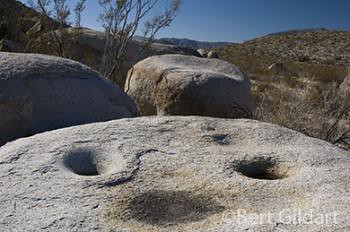Desert Details
©Bert Gildart: After a delightful weekend in Los Angeles we’ve settled back into our Airstream in Anza-Borrego and have spent much of the time working on stories for several magazines. But yesterday, when the afternoon rolled around, we felt an overwhelming desire to return to Blair Valley, home not also the Souths mentioned in my blogs of several posts ago, but also the Kumeyaay Indians. The area provides an exceedingly photogenic landscape in this huge state park, and that was the thrust of our afternoon–trying to obtain story-telling photographs. We wanted to detail the challenges of living in the desert. For this posting we are hoping our photographs–and extended captions–will summarize that challenge.
DESERT AGAVE lured the Kumeyaay Indians to the area, but if you study the thorns, harvesting that species presented challenges. The edges of the agave leaf are covered with thorns, but so is the tip, and this terminal thorn apparently contains a substance that adds to the pain of those who have the misfortune of getting stuck. I’ve learned from such photographic outings to always carry my Leatherman (which contains pliers)–to help extract thorns that invariable stick to clothes and flesh. Photographing thorns of the species was a challenge and I used strobes (two SB-800s) as well as natural light. I set the lens on my D300 Nikon camera body to Macro.
AGAVES are also called century plants, indicative of the length of time it takes to bloom. The plant grows on rocky slopes and is, in fact, the only agave species found under such circumstances. Though it doesn’t take 100 years to blossom, it may take up to 50 years. Just before blooming the agave sends up towering stalks that can approach 15 feet. Eventually, the display attracts a variety of pollinators including bats, hummingbirds, bees, moths as well as other insects and nectar-eating birds.
NATIVE AMERICANS confined their visits to areas containing agaves to times when the plants bloomed. They harvested the seeds produced by the agave and then ground them in morteros. Such circular holes were drilled into a number of the granite boulders located in the upper reaches of Blair Valley. The Kumeyaay also used fibers of the agave and wove them into mats, sandals, belts and ropes.
We’ll be in Anza-Borrego for another day, and then we’re heading to Death Valley for another story–and to rendezvous with friends we met a number of years ago through the Outdoor Writer’s Association of America. We’ll talk shop and work a bit. The chief naturalist there tells me global warming is diminishing populations of Joshua Trees, and that’s something I want to learn more about.
Death Valley is a park we know well as Janie and I coauthored a guide book to the this incredible national park for Falcon Press. For us it’s almost like going back to a former home.





February 10th, 2008 at 8:55 am
Very interesting.. The Agave seems to be a relative to the Yucca plant we have here. When we first moved here I found a few growing wild near our ditchbank. I dug them up and replanted them near the house when I noticed others with them in their landscaping. A neat plant for sure.